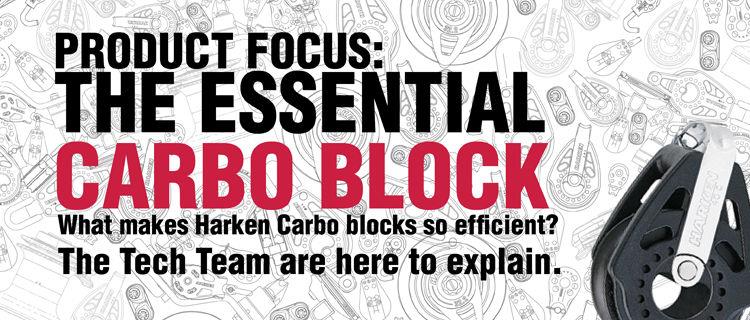
Harken Product Focus: The Carbo Block
by Harken 29 Jan 2019 06:48 UTC

Harken Carbo Block © Harken
With such a huge range of hardware out there, the Harken Tech Team would like to help untangle the different options available. Every month we will be producing a product focus article, giving advice on how to pick the right hardware for the job. This month, we look at our core block range: the Carbo block.

Available in sizes from 18mm to 75mm and in multiple configurations with multiple attachment options, there is a huge range of Harken Carbo blocks available. The Tech Team are here to explain what makes the Harken Carbo block range so reliable and efficient, and how to decide which block you will need for each application.
Nick Craig says: "As with all Harken fittings, Carbo blocks are light, efficient and really robust. They always run smoothly and even with my not-so-gentle touch are seemingly indestructible!"
What makes Harken Carbo blocks work so well?
- Carbo Material: The lightweight Nylon resin used to manufacture the side-plates of our Carbo blocks is reinforced with densely packed glass fibres, which ensures strength in every direction without adding weight, replacing the stainless-steel straps you see on the Classic blocks.
- Bearing Material: Different Harken blocks use different bearings depending on which material ensures the lowest friction, without compromising the required strength of a certain block. For Carbo blocks, we use Delrin acetal resin ball-bearings which are light-weight and low friction; this material has been used in the majority of Harken ball-bearing blocks, all the way back to the first blocks made in the 1970s.
- Race Shape: The race is the surface that the bearings roll on within the block. Similarly to the bearing materials, the shape of the race also has to balance factors of strength against friction. A curved race provides the best support to the ball-bearings, producing a stronger block, whereas a flat race ensures reduced friction but less support to the bearing because the contact area between the bearing and the race is smaller. The design of the race in the Carbo block range combines the best of both worlds: the section of the race where the bearings are engaged with the sheave is curved, to give maximum strength. On the other half of the race where the bearings are simply recirculating, the race is flat for minimum friction.
FUN FACT: You will often see sailors in a chandlery spin the sheave on a block to see how well it spins; usually, the blocks that spin the best have stainless steel ball-bearings on a flat, stainless steel race which provides very little resistance. However, in a real-world application, it takes very little dirt or salt to slow or seize these blocks. Harken blocks are designed to work on the water, which can be a harsh environment, and to remain efficient when loads are applied.
Which blocks should I be using?
- Line Diameter: A key consideration, particularly with sheets, is making sure the sheave is wide enough for the diameter of the rope you are using. A rope with too larger diameter will run against the cheeks and head of the block causing friction.
- Loading: Make sure the block you choose will be working within it's safe working load in order to avoid failures and ensure a long lifespan. Be aware that the angle of deflection around the sheave dictates the loading of the block; a 60 degrees deflection means the block sees 100% of the line load, but at 180 degrees the block sees 200% of the line load. You can look at what is used on other boats of the same class for the same application for clues as to what you should be using, the Tech Team are always available to help determine the right product for an application.
- Alignment: A number of different block designs are available: it is important to make sure the block can align with the load of the line, so that the ball-bearings are loaded evenly and the line does not rub against the side-plates causing friction. The 29mm & 40mm ranges has versions with a swivel head and shackle to give perfect alignment, or a fixed head design to maintain a set alignment. The 57mm & 75mm swivel head versions feature a locking pin to set the shackle in a fixed position.
- Attachment: Shackle attachments allow for quick rigging, whereas fixed head blocks are ideal for attaching to stainless straps on your boat or spars for a maintenance free solution. Tie-on blocks are also now common and the Harken T2 range is great lightweight solution if using a tie-on product, it is important to make sure the attachment point on the boat is completely smooth and will not chafe through the rope.
- Weight vs Friction: Blocks are often purchased at the smallest suitable size to ensure minimum weight and cost; however, increasing the sheave size will often greatly reduce friction making systems more efficient. As an example, 29mm blocks will often be suitable for a dinghy's mainsheet system, with the loads and rope size within the parameters of the block, but using 40mm blocks reduces friction for a system which is more responsive, quicker to ease and less load to pull in.
Maintenance
To ensure your Harken blocks last as long as they should, it is important to maintain them properly. Make sure to rinse them through with fresh water after sailing on salty water, and wash them with warm soapy water when possible. To reduce friction and to repel dirt inside the block, you can use McLube's OneDrop Ball-Bearing Conditioner simply put just one drop of the conditioner into the ball-bearing race and spin the block until all of the surfaces are coated. It is really important not to use a dry lubricant on any ball-bearing blocks cause ball-bearings to skid, rather than roll, which can create flat-spots.